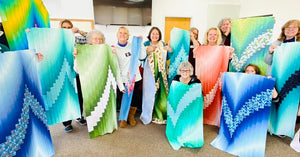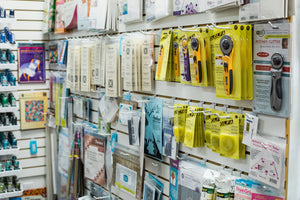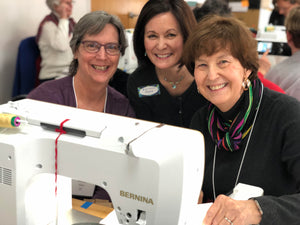Color Fundamentals
Color Fundamentals: Using the Color Wheel
Learning how to use a basic color wheel can be incredibly helpful in choosing fabrics for your quilts. However, be sure to think of the color wheel as a guide rather than a restriction. Any combination of colors has the potential to be fantastic. It may be helpful to keep a collection of photographs, cutouts from magazines, or an online mood board with pinterest of quilts that appeal to you. That way you can start to see the colors that appeal to you the most and look to the color wheel for different ways to use them.
What are Primary, Secondary and Tertiary Colors?
PRIMARY COLORS

The primary colors are red, yellow and blue. Red, yellow and blue are called the primary colors because they are the basis for all other colors. By mixing these three colors together you can create any other color on the color wheel. The primary colors are located at equal distance from one another on a color wheel so that you can see the shades in-between primary and secondary shades.
SECONDARY COLORS

The secondary colors are located midway between the primary colors on the color wheel. That is because they are created by mixing together equal amounts of the nearby primary colors. The secondary colors are Green, Orange and Violet.
TERTIARY COLORS

Tertiary colors are created when you combine the primary and secondary colors together with the colors closest on one side. Examples of tertiary colors include: yellow-green, red-violet, yellow-orange etc. Now that you are familiar with the basics of the color wheel, we can start to talk about how to use these colors in ideal combination with one another.
Simple Color Schemes

This is as simple as it gets, choose one color and then stick to it. However, this is also a great point to talk about variations in color. The variations of color are shade, tone and tints.
Shade: Shade is the addition of black to make a color darker
Tone: Tone is created by adding gray to color to desaturate or mute the intensity
Tint: A tint is the addition of white to make a color brighter
The variations mean that monochromatic schemes can be anything but boring. Try lining fabric in a similar color up from darkest to lightest, high saturation to muted tone – don't be afraid to experiment and see what combinations you like!

You've probably heard the old saying – "love thy neighbor" well the analogous color scheme is one of neighborly love. That is because the analogous color scheme uses colors that are adjacent to each other on the color wheel. While the analogous scheme is similar to the monochromatic one, there are more subtle nuances that can be achieved with a slight tonal shift in one direction or the other on the color wheel.
Intermediate Color Schemes

Doesn't everyone love a sincere and genuine compliment? Well complementary colors - (yes, it is spelled a bit differently) – however complementary colors "flatter" the color which lives on the opposite side of the color wheel. These create the highest contrast, so a good rule of thumb is to choose one color as your dominant or background color with its complement used more sparingly as a "popper" color – drawing emphasis to the areas that you would like to stand out. Popper colors can make for fantastic quilt borders, for example.

To create a split complementary color scheme, take one color and match it to the two colors which are adjacent to its complementary color. This is a great color scheme for beginners because it creates contrast but not in such a diametrically opposite was as straight complementary colors. There are many variations of harmonious color schemes that can be created using split complementary colors.
Advanced Color Schemes

Are you ready for 3 times the excitement? The triadic color scheme uses not one, not two, but three colors equally spaced around the color wheel. This scheme is popular among creatives because it offers strong visual contrast while retaining balance, and color richness. It creates a balanced and harmonious look.

Tetradic is the richest color scheme of all because it uses four different colors which are arranged into two complementary pairs. It can be a bit tricky to pull off, but the stunning results can be worth the extra effort. To achieve balance, it may be recommended to not use each color in equal amounts but rather to use a dominant color and accent it with its complement.
Come on into Quilt Beginnings for more colorful inspiration!





